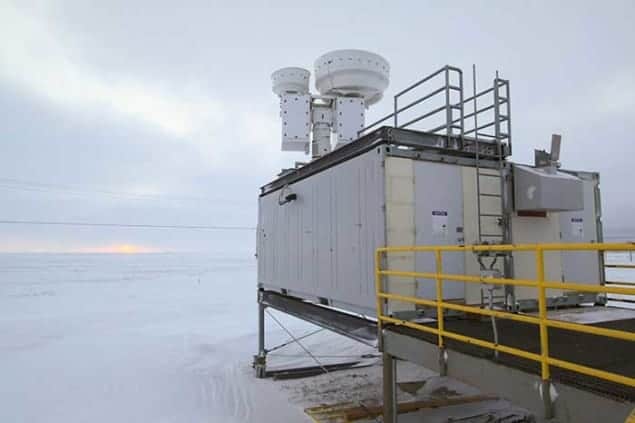
Scientists in the US have made the first direct measurement of the increase in the greenhouse effect caused by rising carbon-dioxide levels in the atmosphere. Their ground-based observations were carried out over a period of 11 years at two different locations – Oklahoma and Alaska – and show that infrared emissions from carbon dioxide have increased during that time in agreement with theoretical predictions for man-made climate change. Their study also includes the first direct observation of the large annual dip in greenhouse heating that occurs in spring, when there is a sharp increase in the uptake of carbon dioxide by plants.
Much of the near-infrared, visible and ultraviolet light from the Sun passes straight through the atmosphere and warms the surface of the Earth. The warm surface emits infrared light that gets absorbed by carbon dioxide and other atmospheric gases, before being re-emitted in all directions. Much of this emission is downwards, making the surface of the Earth warmer than if it had no atmosphere. The strength of this greenhouse effect is quantified in terms of “radiative forcing” – the difference between the rate at which solar energy is absorbed by the Earth and the rate at which it is radiated back into space.
Atmospheric struggle
Although the role of carbon dioxide as a greenhouse gas has been well established by lab experiments, scientists have struggled to measure its effect in the real atmosphere, which contains a mixture of different greenhouse gases, as well as clouds and other weather-related phenomena. Now, however, Daniel Feldman and colleagues at the Lawrence Berkeley National Laboratory and other institutes in the US have used two ground-based Atmospheric Emitted Radiance Interferometer (AERI) facilities to measure how much infrared light is returned to the surface of the Earth from carbon dioxide alone. According to Feldman, the team has also “controlled for other factors that would impact our measurements, such as a weather system moving through the area”.
Feldman and colleagues examined a total of 8300 measurements made in Oklahoma and 3300 made in northern Alaska between 2000 and 2010. They found that radiative forcing by carbon dioxide has increased in both locations at a rate of about 0.2 W m–2 per decade. To put that into perspective, scientists have calculated that the total forcing today caused by human-related carbon-dioxide emissions since the start of the Industrial Revolution is about 1.82 W m–2.
The results agree with radiative-forcing values calculated using CarbonTracker 2011, which is a measurement and modelling system that provides carbon-dioxide concentrations at a regional level. This means the measurements back up predictions that the greenhouse effect is becoming more significant as a result of increased carbon-dioxide emissions from human activities such as the burning of fossil fuels. The results also suggest that current climate models are doing a good job of describing the impact of carbon dioxide on the Earth’s climate.
Critical link
“Numerous studies show rising atmospheric carbon-dioxide concentrations, but our study provides that critical link between those concentrations and the addition of energy to the [Earth] system, or the greenhouse effect,” Feldman says. His team’s measurements also show the sharp annual drop in radiative forcing that occurs in the spring when plants absorb large amounts of carbon dioxide from the atmosphere. While this effect is predicted by theory, this is the first time the effect of plants has been measured directly.
The research is described in Nature.



